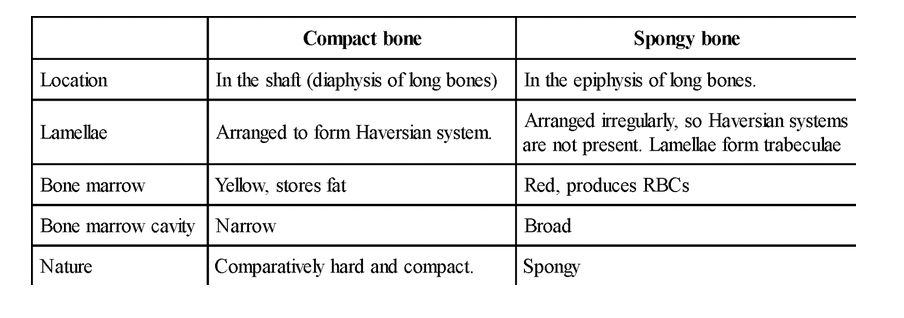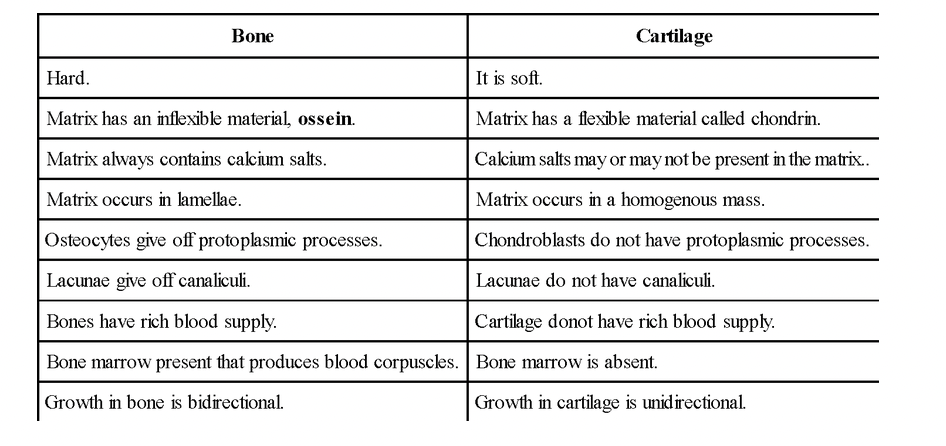Skeletal Tissues
Animal Tissues of Class 11
Forms the endoskeleton of the vertebrates.
Provide support to the body, protect various delicate organs and help in locomotion.
Mesodermal in origin and consists of cartilage and bone.
Cartilages
- Soft, semi-rigid and flexible connective tissue.
- Surrounded by a sheath of dense connective tissue called perichondrium, which also contains blood vessels.
- The cells of mature cartilage, which are larger in size with a few surface projections are called chondrocytes; they occur singly or in groups in spaces called cartilage lacunae.
- Young, immature cells which are small in size and bear many surface projections are called chondroblasts which are metabolically more active cells than chondrocytes.
- Blood vessels enter the cartilage through cartilage canals.
- The chondrocytes secrete the flexible matrix called chondrin.
- Main component of chondrin is mucoprotein.
- The growth of cartilage is always from the periphery (uni-directional)
- Depending upon the proportions of fibres to matrix, and kind of fibres present, cartilage is classified as hyaline elastic and fibrous.
Hyaline Cartilage
- In hyaline cartilage or gristle, fibres are absent and the matrix is translucent.
- Most abundant kind of cartilage.
- Found upon articular surfaces at joints of long bones forming articular cartilage.
- Forms the costal cartilages at the ventral ends of the ribs.
- Helps to form the nose, larynx, trachea, bronchi and bronchial tubes leading to the lungs.
- Most of the embryonic skeleton consists of hyaline cartilage and skeleton of elasmobranch (cartilagenous) fishes.
Elastic Cartilage
- The cartilage with elastic fibres.
- Provides strength and maintains the shape of certain organs.
- Found in the wall of larynx, ear pinna, epiglottis and eustachian tubes.
Fibro cartilage
- White fibrocartilage carries thick dense bundles of collagen fibres in matrix and is the strongest cartilage.
- Perichondrium is absent in white fibrocartilage.
- Occurs in joints between vertebrae (intervertebral disc) and also in pubis symphysis.
- Dead body is slightly longer than alive due to relaxation of intervertebral disc.
- Calcified cartilage is formed by the calcification of hyaline cartilage.
- Calcified cartilage is hard and found in suprascapula of pectoral girdle and pubis of pelvic girdle in frog.
Bones
- Solid, rigid and strong connective tissue. The matrix is made up of an organic component called ossein.
- Bone is the hardest tissue in the body and provides support to various organs. Major component of vertebrate bone is calcium phosphate.
- Other components include calcium carbonate, magnesium phosphate and sodium chloride. All these salts are collectively called as hydroxyapatites.
- The mineral salts compose 67% of the weight of the bone, the organic phase comprising collagenous fibres make up the remaining 33%.

Fig. A-B. Haversian System in Mammalian Bones; C. An enlarged Osteocyte
- Bone is studied in two forms – decalcified and dried.
- If a bone is burnt, then the organic phase is destroyed and the bone is said to be dried.
- If a bone is kept in dilute acid for few days, it becomes soft and flexible. This is called decalcification of the bone.
- A bone kept in KOH remains unaffected.
- Bone is surrounded by a dense, white, fibrous sheath called periosteum. Bundles of periosteal collagen fibres, called Sharpey-Schafer fibres.
- Medullary or marrow cavity is lined with endosteum.
- The matrix of the bone is made up of a protein called ossein, being deposited in concentric rings called lamellae between periosteum and endosteum.
- Between adjacent lamellae, numerous small cavities called lacunae are present.
- A lacuna gives off numerous fine radiating channels called the canaliculi. Within the lacuna is present a bone forming cell called osteocyte.
- Matrix between periosteum and endosteum consists of numerous fine channels called Haversian canals which constitute the Haversian system or osteon.
- Haversian system includes haversian canal, surrounding lamellae, lacunae, osteocytes and canaliculi. It is found in long bones of mammals to provide extra nutrition to living parts of matrix.
- Presence of Haversian system is the characteristic of mammalian bone, absent in spongy bones of mammals.
- Haversian canal contains an arteriole, venule, nerve fibres, fat cells, osteoblasts and areolar tissue.
- Haversian canals are interconnected by transverse canals known as Volkmann’s canals.
- The shaft or long portion of a bone is called diaphysis; the extremities of the bone are called epiphysis.
- The hyaline cartilage covering the epiphysis of a bone where the bone forms a joint with another bone is called articular cartilage.
- On the basis of texture, a bone is of two types - spongy or cancellous or tubercular bone and compact or periosteal or dense bone.
Table : Differences between compact and spongy bones

- Long bones like humerus, femur etc. possess bone marrow cavity internal to endosteum. This cavity is filled with soft, semisolid fatty neuro-vascular tissue called bone marrow or myeloid tissue.
Two types of bone marrow - red bone marrow and yellow bone marrow are found.
Table : Differences between red bone marrow and yellow bone marrow

- Bones of the birds have air spaces in between, hence are called pneumatic bones.
- The process of bone formation in the body is called osteogenesis or ossification.
- Formation of membranous bones from dermis is called intramembraneous ossification.
- Formation of a cartilagenous bone from a cartilage is called endochondral ossification.
- Sesamoid bone is formed by the ossification of tendon and sometimes ligaments.
- Osteoclasts are the bone dissolving cells.
- Study of bone is known as osteology.
- Vitamin D is essential for normal growth and maintenance of bones.
- Deficiency of vitamin D produces rickets in children and osteomalacia in adults.
- Paget’s disease is characterized by irregular thickening and softening of bones resulting in deformation.
- Osteomyelitis : Inflammatory disease of bone due to infections.
Table : Differences between Bone and Cartilage

- Tissue
- Types of Animal Tissues
- Epithelial Tissue
- Covering and Lining Epithelium
- Glandular Epithelium
- Connective Tissue
- Skeletal Tissues
- Vascular Tissues
- Origin of Blood Cells
- Erythrocytes/RBC's
- Leucocytes/WBC's
- Blood Clotting
- Lymph
- Muscular Tissue
- Nervous Tissue
- Integument
- Exercise 1
- Exercise 2
- Exercise 3
- Exercise 4
- Exercise 5
- Exercise 6









